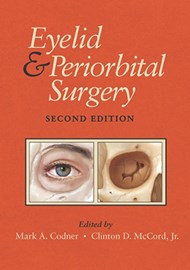When the book to be reviewed arrived in the post we were taken aback – popping the volumes on the scale, each weighed in at 2kg. Reviewing 4000grams of oculoplastics seemed insurmountably daunting until we noticed four things: first, this book is full of high-quality illustrations – almost 3000 in fact. Second there is plenty of white space on the pages for notes and it is set out in the clearest possible ways including with flow charts for management. Third, it is a second edition from 2016, meaning that it was clearly of sufficient quality to have merited a further edition. And finally, the book is written by two highly esteemed Southern US gentlemen from Atlanta – the late Dr Marc Codner who passed away at the age of 60 last year, and his senior colleague ‘Sonny’ McCord (who trained with Dr Castravejo – of surely everyone’s favourite needleholder fame?!)
Focusing on this duo for a second is helpful as it underlies the ethos of the book – though Dr Codner did a fellowship with Dr McCord the former is a general plastic surgeon and the latter an oculoplastic specialist. This sort of dual approach and co-working is helpful as it ensures that one does not have to be an ophthalmologist to understand this set of books. These volumes are stand-alone and comprehensive, covering almost all the periocular surgery one could wish to know including function and anatomy (part 1), aesthetic surgery (part 2) as well as reconstructive (part 4) and orbital and lacrimal surgery (part 5). Unusually for a textbook of this length the authors have written almost the entirety themselves but invited contributions in areas where they have felt less expert. For example, since the publication of the first edition a decade ago non-surgical treatments have become an important adjunct to oculoplastic practice. This new edition helpfully contains an entire section (Part III) on this area which the authors have invited others to contribute to, including allied healthcare professionals.
As surgeons who have trained extensively in oculoplastics overall we were pleased to see subjects covered well and thoroughly. If one is allowed one criticism – the approach is very much based on the authors’ experience and some procedures such as the destructive fasanella-servat for ptosis are not placed in context. Likewise, the entire ptosis section has algorithms for management which are at best confusing or counter to our experience – for example silicone rods are advocated when there is poor eye protection – the opposite of our preference.
This is probably not a book aimed at those of us who have fellowship experience. Rather this book is perfect for those who are being fellowship trained or find that their work is increasingly involving eyelids and the midface, be they general ophthalmologists or plastic surgeons. It represents an accessible foundation to our specialty and is complemented by an online version (for easier transport) and some 30 surgical videos. No wonder then that it won first prize in the British Medical Association’s Medical Specialties Award when it came out.
These volumes were previously reviewed by Christopher David Jones - see the review here.






